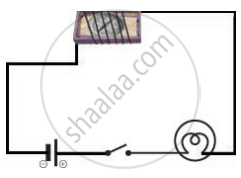Advertisements
Advertisements
Question
Make a match
| A group | B group |
| 1. Fluid | a. Higher pressure |
| 2. Blunt knife | b. Atmospheric pressure |
| 3. sharp needle | c. Specific gravity |
| 4. Relative density | d. Lower pressure |
| 5. Hecto pascal | e. Same pressure in all directions |
Solution
| A group | Answers |
| 1. Fluid | e. Same pressure in all directions |
| 2. Blunt knife | d. Lower pressure |
| 3. sharp needle | a. Higher pressure |
| 4. Relative density | c. Specific gravity |
| 5. Hecto pascal | b. Atmospheric pressure |
RELATED QUESTIONS
A ball is hanging by string from the ceiling of the roof. Draw a neat labelled diagram showing the forces acting on the ball and the string.
Name the physical quantity that causes motion in a body.
Name the S.I. unit of force and define it .
A cricket player holds a cricket ball of mass 100 g by moving his hands backward by 0.75 m. If the initial velocity of the ball is 108 kmh−1, find the retarding force applied by the player.
Explain the following:
Why is it dangerous to jump out of a moving vehicle? How can the danger be minimised?
What is the ratio of SI to CGs units of force?
Gravitational force is a ______ force.
In the circuit shown in figure, when the key is closed, the compass needle placed in the match box deflects. Name the force which cases this deflection.

In the circuit shown in figure, when the key is closed, the compass needle placed in the match box deflects. Name the force which cases this deflection.

During dry weather, clothes made of synthetic fibre often stick to the skin. Which type of force is responsible for this phenomenon?
